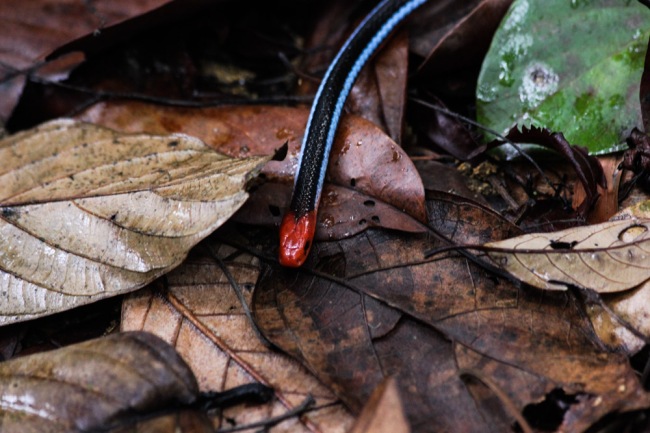This week the Drongos had some special guests with us, the Toddycats! The Toddycats are nature and environment volunteers with the upcoming Lee Kong Chian Natural History Museum, and they run another trail in MacRitchie, called the Venus Loop that is located further down Upper Thompson. The Toddycats also manage the Love Our MacRitchie Forest movement, which was launched in response to the proposed Cross Island Line (CRL) that would cut through MacRitchie. The Toddycats hope to educate the public through their walks about the fragile ecosystem and stunning biodiversity we have here through their trails, and the Drongos are hoping to follow in their footsteps. So in a way, the Toddycats are our mentors, and we certainly learnt a lot from them on this trail.

This trail was also pretty special because it was the first time our volunteers were presenting to non-Drongos, and we are proud to say that they are shaping up to be promising guides!
However, we all certainly still had a lot to learn, as the Toddycats amazed us with their uncanny ability to spot all sorts of biodiversity along the trail. So for today’s post, there are a whole lot more animals, and we hope that with more experience we can someday be as sharp as the Toddycats in spotting such amazing creatures!
This Ornate Coraltail (Ceriagrion cerinorubellum) was flitting around near the boardwalk. The Coraltail is a damselfly, which is not the same as a dragonfly, even though they look very similar. Both dragonflies and damselflies are from the order Odonata but are generally classified into two different suborders, with dragonflies under Anisotera and damselflies under Zygoptera. The most obvious difference between dragonflies and damselflies is that damselflies have a long, slender body as compared to dragonflies, which have shorter, stockier bodies.
We were very lucky for this trail as we spotted both a Malayan Blue Coral Snake (Calliophis bivirgatus) and Wagler’s Pit Viper (Tropidolaemus wagleri )(photo below), highly venomous snakes that we had not seen since our first recce of the trail. A fun (and rather frightening) fact that we learnt from the Toddycats was that the Malayan Blue Coral Snake is also known as the Hundred Paces Snake, because its venom is so powerful that a person can only make it about a hundred paces after being bitten before they die. Ouch.
It seems that the snakes like to bask near the boardwalk because the vegetation is not as dense there and thus has more sunlight. Because venom takes a while to make, it a good thing to remember that snakes generally will not attack non-prey animals (for example, us) unless they are highly threatened or cornered, so if you ever see a snake, give it some room and back away slowly so as to not startle it. Always ensure that the snake has an escape route, and you should be fine!
Another interesting reptile we saw today was a Clouded Monitor Lizard (Varanus nebulosus), named as such because it has beautiful yellow cloud-like markings on its back. Monitor lizards are closely related to Komodo Dragons (the largest lizards in the world which grow up to 3 meters long), but thankfully all the Monitor Lizard species in Singapore are unable to grow that big.
This Common Sailor butterfly (Neptis hylas papaja) was resting on some Resam ferns (Dicranoptris linearis). Both the Common Sailor and Resam like the sun, and both are common species found on nature reserve fringes.
Speaking of butterflies, we found this fantastical caterpillar (Eudocima smaragdipicta) creature so strange that it really seems otherworldly. Other than the weird Pokémon ball-looking patterns found on its body, the oddly shaped “head” at the end of the caterpillar facing up in this photo is actually its tail! The caterpillar uses its false head to give the impression of a rearing snake as it raises its behind, serving as a defense against birds and other hungry predators.
While we are on the topic of fake snakes, we also found the flower of the Rattan Plant (above) and the resulting fruit (below). The scaly fruit develops in between the “cups” of the long, segmented flower, and the cups only fall off after the fruit is ripe, exposing the fruit bunches.
As most of us know, the main stem of the plant is often used to make furniture and other products (like canes), but did you also know that the fruit produces a red resin known as “dragon’s blood” and is often used to dye violins?
Well, that is about it for this trail! We would like to give special thanks to the Toddycats Chloe Tan, David Tan, Yi Yong, Sean Yap and Amanda Lek for taking the time to come down to our trail with us! We hope that as we develop our own stories and gain experience as guides that we will one day make you guys proud. (:
(Thanks to David Tan, Sean Yap and Samuel Chan for pointing out some initial mistakes in the post!)
For more photos, check out our Flickr albums!





























